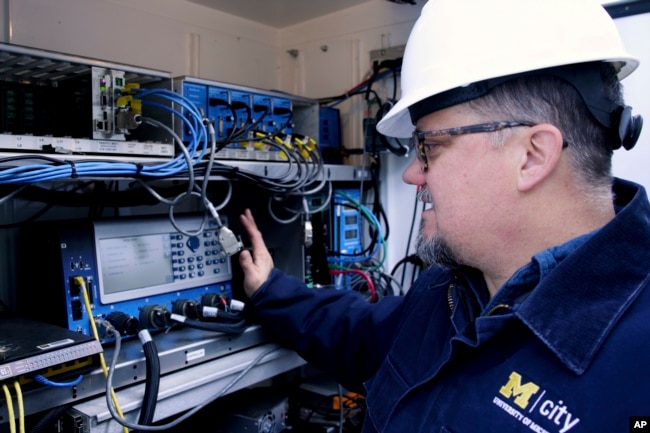AUDIO
Researchers: Smarter Vehicles Could Greatly Change Traffic Signals

Researchers say the rise of more smart and connected vehicles on American roads could lead to big changes for traffic signals.
The current U.S. traffic signal system has been in existence for more than 100 years. But experts are now studying ways to link technology-equipped vehicles to signal systems in an attempt to improve safety and traffic flows.
One research effort is led by a team at North Carolina State University. Engineering professor Ali Hajbabaie is the leader of that research. He told The Associated Press one major change that signal systems could see is different colored lights.
Most U.S. traffic signals currently include three lights to direct drivers at intersections: red, yellow and green. But Hajbabaie said it might make sense to add a fourth color, possibly white.

This color could inform motorists when there is a large collection of self-driving vehicles in a particular area. When many self-driving vehicles are present, the additional light would signal other drivers to follow the lead of those vehicles.
“When we get to the intersection, we stop if it's red and we go if it's green," said Hajbabaie. “But if the white light is active, you just follow the vehicle in front of you.”
The North Carolina State team estimated that such changes are likely years away. Hajbabaie said one reason for this is because this kind of system would require between 40 to 50 percent of all vehicles on the road to be self-driving.
Sandy Karp is a spokesperson for Waymo. Waymo is a self-driving vehicle company owned by Google’s parent, Alphabet. She told the AP that Waymo had already launched ride-sharing services that use full self-driving vehicles in Los Angeles, California and Austin, Texas. Those services do not use a fourth traffic light.

In an email to the AP, Karp said she thought it was good that researchers are currently “thinking creatively” about ways to change traffic light signals to improve safety and traffic flows. However, she said that officials and companies should think very carefully before deciding on, and moving forward with, major infrastructure changes.
Researchers at the University of Michigan are also testing different methods. They have carried out a test program in an area outside the city of Detroit. Their research collects data on the speed and location of General Motors (GM) vehicles in the area. The data has been used to change the timing of city traffic lights in an effort to improve traffic flows.
Henry Liu is a civil engineering professor at the University of Michigan. He helped lead the research. He said the launch of a new U.S. traffic system could be a lot closer than people might think.
Liu said that even with as few as 6 percent of vehicles connected to the GM system, there is still enough data to change the timing of the traffic lights enough to smooth traffic flows.

The area near Detroit where the testing is taking place has 34 traffic signals. It was chosen because lights in the area are set to change at the same times each day. This is the case for more than half of traffic signals nationwide. These signals are not connected to cameras or sensors to watch traffic flows in real time.
Liu noted that higher-tech solutions will require cities to make complex and costly investments.
“The beauty of this is you don’t have to do anything to the infrastructure,” Liu said. “The data is not coming from the infrastructure. It’s coming from the car companies.”
Danielle Deneau is the director of traffic safety at the Road Commission in Oakland County, Michigan. She said results of the University of Michigan research changed the timing of green lights only by a few seconds. However, Deneau added, even that was enough to improve traffic flows.
___________________________________________
Words in This Story
intersection – n. the place where two or more streets meet or cross each other
infrastructure – n. the system of public works of a country, state, or region; also : the resources (such as buildings or equipment) required for an activity
location – n. the place or position where something happens
https://learningenglish.voanews.com/a/researchers-smarter-vehicles-could-greatly-change-traffic-signals/7609631.html